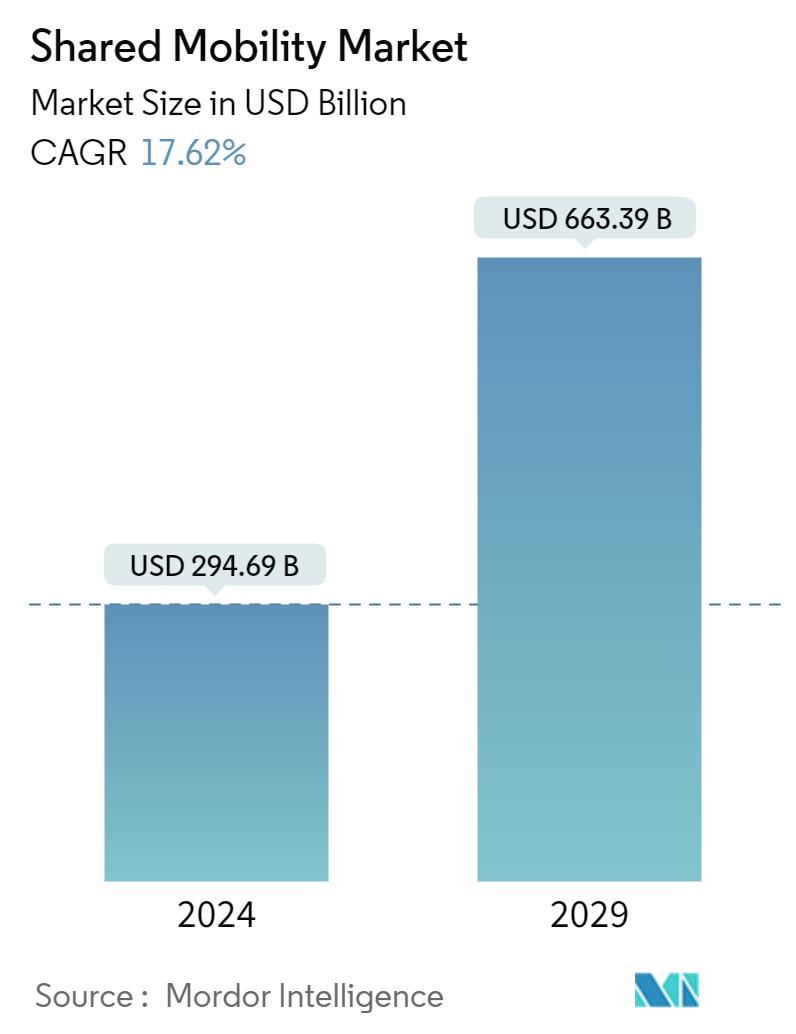Market Size of Shared Mobility Industry

| Study Period | 2019 - 2029 |
| Market Size (2024) | USD 294.69 Billion |
| Market Size (2029) | USD 663.39 Billion |
| CAGR (2024 - 2029) | 17.62 % |
| Fastest Growing Market | Europe |
| Largest Market | Asia Pacific |
Major Players
*Disclaimer: Major Players sorted in no particular order |
Shared Mobility Market Analysis
The Shared Mobility Market size is estimated at USD 294.69 billion in 2024, and is expected to reach USD 663.39 billion by 2029, growing at a CAGR of 17.62% during the forecast period (2024-2029).
In the long term, consumers' increasing preference toward ride-hailing, car-sharing, and rental services owing to the lower cost of transportation will drive the shared mobility market across the world. Due to the increasing traffic congestion and higher ownership cost of purchasing new vehicles, consumers tend to avail ride-hailing as a preferred medium for their daily commutes. Further, the integration of various new entrants with a strong competitive edge is expected to disrupt the market. For instance, inDrive, a ride-hailing platform, offers a bid-based platform suitable for both drivers and consumers, as it helps negotiate a fixed price for short-distance travel and avoids the surge price charged by other competitors.
- In Q3 2023, Beijing, Changchun, and Chongqing were the leading cities in China with the highest rush hour congestion. The rush hour congestion index in Beijing touched 2.09 in Q3 2023, followed by Changchun with an index of 2.05 and Chongqing with an index of 1.97 during the same period.
- According to the TomTom Index, London, Dublin, and Toronto were the major city centers across the world with the highest traffic congestion in 2023. The average time to travel 10 km in London is 37 minutes and 20 seconds, the highest in the world.
The ease of travel and the convenience of driving through traffic are leading to an increasing demand for two-wheeler hailing and sharing services, especially in Asia-Pacific. Some prominent countries with a significant shared micro-mobility market across Asia-Pacific include India, China, and Vietnam, which are attributed to the lower cost charged compared to availing a car-hailing service. Further, in recent years, there has been a massive penetration of electric two-wheelers in the shared mobility industry to complement the government's decarbonization effort, which is expected to foster the growth of the shared mobility market between 2024 and 2029.
- In August 2023, Green and Smart Mobility (GSM) announced the commencement of its e-motorcycle-hailing service in Vietnam to solidify its market position and compete with players such as GoJek and Grab. Further, the company stated its plan to operate 60,000 e-motorcycles on Vietnamese roads in five localities across the country.
Moreover, increasing investment in the corporate sector and the worldwide urbanization rate contribute to consumers migrating to urban areas for better employment opportunities. With more consumers migrating to urban areas, there is a massive demand for jobs in these areas, which, in turn, is expected to expand the market for employee transportation needs. To cater to the increasing need for employee transportation, various shared mobility players are strategizing to enter this space by offering on-demand shuttle services, which, in turn, positively impact the demand for the shared mobility market worldwide.
Shared Mobility Industry Segmentation
Shared mobility refers to a variety of transportation services, including ride-hailing, bike-sharing, car-sharing, rental and leasing, shuttle services, and bus services. These types of services can be availed individually or as a group to share the cost of the trip.
The shared mobility market is segmented by type, vehicle type, business model, propulsion type, and geography. By type, the market is segmented into ride-hailing, car sharing, shared micro-mobility (e-bikes, e-scooters, etc.), rental and leasing, and others (shuttle services, bus services, etc.). By vehicle type, the market is segmented into passenger cars, light commercial vehicles (pickup vans, etc.), buses and coaches, and two-wheelers. By business model, the market is segmented into peer-to-peer (P2P), business-to-business (B2B), and business-to-consumer (B2C). By propulsion type, the market is segmented into internal combustion engine (ICE) and electric. By geography, the market is segmented into North America, Europe, Asia-Pacific, and Rest of the World.
The report offers market size and forecasts for the shared mobility in value (USD) for all the above segments.
| By Type | |
| Ride-Hailing | |
| Car Sharing | |
| Shared Micromobility (E-Bikes, E-Scooters, etc.) | |
| Rental and Leasing | |
| Others (Shuttle Services, Bus Services, etc.) |
| By Vehicle Type | |
| Passenger Cars | |
| Light Commercial Vehicles (Pickup Vans, etc.) | |
| Buses and Coaches | |
| Two-Wheelers |
| By Business Model | |
| Peer-to-Peer (P2P) | |
| Business-to-Business (B2B) | |
| Business-to-Consumer (B2C) |
| By Propulsion Type | |
| Internal Combustion Engine (ICE) | |
| Electric |
| By Geography | |||||||
| |||||||
| |||||||
| |||||||
|
Shared Mobility Market Size Summary
The shared mobility market is poised for significant growth, driven by an increasing consumer preference for cost-effective transportation solutions such as ride-hailing, car-sharing, and rental services. This shift is largely due to rising traffic congestion and the high costs associated with vehicle ownership. The market is expected to experience substantial expansion as new entrants with competitive advantages, like inDrive's bid-based platform, disrupt traditional models. The Asia-Pacific region, in particular, is witnessing a surge in demand for two-wheeler hailing and sharing services, fueled by the lower costs compared to car-hailing services and the penetration of electric two-wheelers. This trend is supported by government decarbonization efforts, which are encouraging the adoption of electric vehicles in shared mobility fleets.
The market's growth is further bolstered by urbanization and increased corporate investment, leading to a higher demand for employee transportation solutions. Shared mobility players are responding by offering on-demand shuttle services to meet this demand. The passenger car segment is also expanding, driven by the need for ride-hailing and rental services, as well as the rising demand for electric vehicles. The market is characterized by a high level of competition, with numerous international and domestic players vying for market share. Strategic partnerships, mergers, and acquisitions are expected to enhance profitability and expand customer bases, as companies like Yulu and Hoop Carpool explore new opportunities in emerging markets.
Shared Mobility Market Size - Table of Contents
-
1. MARKET DYNAMICS
-
1.1 Market Drivers
-
1.1.1 Increasing Preference of Consumers toward Ride-Hailing Services is Expected to Foster the Growth of the Market
-
-
1.2 Market Restraints
-
1.2.1 Strict Government Regulations to Govern the Shared Mobility Industry Hampers the Growth of the Market
-
-
1.3 Industry Attractiveness - Porter's Five Forces Analysis
-
1.3.1 Threat of New Entrants
-
1.3.2 Bargaining Power of Buyers/Consumers
-
1.3.3 Bargaining Power of Suppliers
-
1.3.4 Threat of Substitute Products
-
1.3.5 Intensity of Competitive Rivalry
-
-
-
2. MARKET SEGMENTATION (Market Size in Value - USD)
-
2.1 By Type
-
2.1.1 Ride-Hailing
-
2.1.2 Car Sharing
-
2.1.3 Shared Micromobility (E-Bikes, E-Scooters, etc.)
-
2.1.4 Rental and Leasing
-
2.1.5 Others (Shuttle Services, Bus Services, etc.)
-
-
2.2 By Vehicle Type
-
2.2.1 Passenger Cars
-
2.2.2 Light Commercial Vehicles (Pickup Vans, etc.)
-
2.2.3 Buses and Coaches
-
2.2.4 Two-Wheelers
-
-
2.3 By Business Model
-
2.3.1 Peer-to-Peer (P2P)
-
2.3.2 Business-to-Business (B2B)
-
2.3.3 Business-to-Consumer (B2C)
-
-
2.4 By Propulsion Type
-
2.4.1 Internal Combustion Engine (ICE)
-
2.4.2 Electric
-
-
2.5 By Geography
-
2.5.1 North America
-
2.5.1.1 United States
-
2.5.1.2 Canada
-
2.5.1.3 Rest of North America
-
-
2.5.2 Europe
-
2.5.2.1 Germany
-
2.5.2.2 United Kingdom
-
2.5.2.3 France
-
2.5.2.4 Italy
-
2.5.2.5 Rest of Europe
-
-
2.5.3 Asia-Pacific
-
2.5.3.1 China
-
2.5.3.2 India
-
2.5.3.3 Japan
-
2.5.3.4 South Korea
-
2.5.3.5 Rest of Asia-Pacific
-
-
2.5.4 Rest of the World
-
2.5.4.1 South America
-
2.5.4.2 Middle East and Africa
-
-
-
Shared Mobility Market Size FAQs
How big is the Shared Mobility Market?
The Shared Mobility Market size is expected to reach USD 294.69 billion in 2024 and grow at a CAGR of 17.62% to reach USD 663.39 billion by 2029.
What is the current Shared Mobility Market size?
In 2024, the Shared Mobility Market size is expected to reach USD 294.69 billion.

